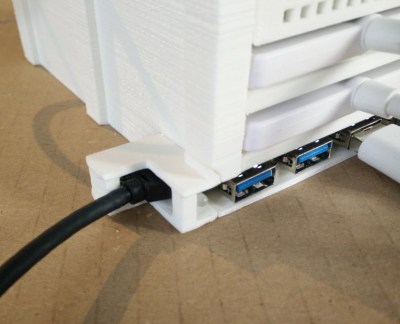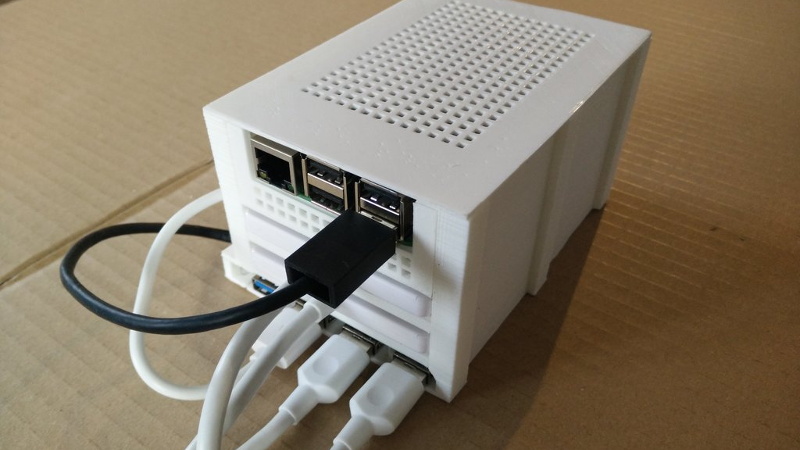Back in 2018, [Paul-Louis Ageneau] created a 3D printed network-attached storage (NAS) enclosure for his Raspberry Pi. The design worked well, the Internet liked it when he posted the details on his blog, and all was right with the world. But of course, such glories are fleeting. Two years later that design needs updating, and thanks to the parametric nature of OpenSCAD, he’s been able to refresh his design for another tour of duty.
 In our book, this is as much a cautionary tale as it is a success story. On one hand, it’s a testament to the power of CAD and desktop 3D printing. That a design can be tweaked and reproduced down the line with only minimal hassle is great for folks like us. But it’s also a shame that he didn’t get more than two years before some of the parts he used in the original NAS became unobtainium.
In our book, this is as much a cautionary tale as it is a success story. On one hand, it’s a testament to the power of CAD and desktop 3D printing. That a design can be tweaked and reproduced down the line with only minimal hassle is great for folks like us. But it’s also a shame that he didn’t get more than two years before some of the parts he used in the original NAS became unobtainium.
The main issue was that the integrated USB hub he used for the first version is no longer available, so the design had to be modified to accept a similar board. Unfortunately, the new hub is quite a bit wider than the old one. Resizing the entire case isn’t really an option since the Pi has to slide into it, so the hub now bumps out a bit on one side. He’s added a printable cover that cleans it up a bit, but the asymmetrical look might be a problem for some. While fiddling with the design, he also changed around the cooling setup so a larger fan could be mounted; now that the Raspberry Pi 4 is out, it can use all the cooling help it can get.
We covered the original version of the printed NAS back when it was first released, and it’s always good to see a creator coming back and keeping a project updated; even if it’s because hardware availability forced their hand.
















Looks bad IMHO. Isn’t a case’s purpose is to not have random wires all around visible? Especially ones that connects to itself.
The RPI design force you to do that (or to have a big freaking case, or some custom pcb).
not really, there’s plenty of depth in this case to keep everything internal, then run a panel mount network jack to the outside, a 6 inch one might cost you a penny on ebay. This is how I did my game system in a atari shell, everything is internal and uses 2x usb and 1 HDMI male to panel mount female. Its a shame that no one ever thinks of that and has half the pi’s ass hanging out with no reason
While I agree there is space to do a neater job the convenient and simple build with a few cables round the outside to join it all up isn’t that bad. Its neater than my Pi NAS which is just a jumble of cables and caddies stuffed into an unused space in the telephone table..
It is not that much work to make an integrated Ethernet connector holder as part of the *3D printed case*. Just a box with a lid and a hole on the bottom for the wires to come out. Crimp a RJ45 with CAT6 cable cut to correct length and solder to the connector.
Use a keystone jack made to snap into a wall plate, and copy the wall plate hole into the 3D printed case.
ah, you did the same thing? i put a MiBox 3 (with a hub for Ethernet, power, HDMI & USB ports) inside an Atari 2600. it sits in front of my TV and serves as a cool-looking HTPC. plays Netflix, YouTube etc. alongside a suite of emulators.
love a good retrofitting project, do you have pictures?
Yea, as much as I like the Pi, I’m pretty disappointed that at this point, they haven’t added an M.2 storage option and/or at least an internal header to access the USB ports. NAS use is such a common task for the Pi, having to hobble together components with a rat’s nest of looping cables is inexcusable at this point. I stopped buying Pis at the 3B and won’t again until these issues are addressed.
If you want a SBC perfect for your specific use case use a pi compute module on a custom carrier PCB to have only what you want where you want it. No SBC can give you everything you want where you want it but the compute module lets you have the best of both worlds with a little work – great support, all the core computing parts sorted and all the gpio/cpu buses running out to the pins.
First, it looks better than anything I’ve cobbled together in CAD and printed, so kudos!
But help me understand, whats the point of putting a four port USB hub in a two bay NAS when your “system board” has 4 USB already? You can already connect both and have room for temporarily connected thumbdrives, right? Are you trying to eliminate the need for the Pi to power the drives?
He uses the USB hub as the power supply, both to power the HDs connected to it, and to power into the Pi over the 3rd white USB cable.
It doesn’t show it in the above picture, but on the blog you can see there are two connectors on the plastic piece that sticks out strangely on the bottom left.
It shows the uplink into the Pi, but on the other side is another that goes to the hubs power supply.
Yeah, I could see how its wired. I just wasn’t sure if I was missing something about max total amperage on the Pi + USB devices that made the hub necessary.
The temperature issues with the RPi 4 are greatly exaggerated. It will run fine without heatsinks or fans under normal load. With a heat sink and or a small fan, it goes down to RPI3+ temps even under loads.
The main cause for the panic was the fact that they released the product during a heat wave! My Laptop could not cope with that even!
Also the firmware needed some power tweaking to run cooler. Bigger fan and better airflow are never a bad thing though – lets it cope with real excessive ambient temperatures better.
There is still a possibility that it could consume that amount of power under full load. Power management can only do so much if the part is under full load. Keeping a NAS cool would improve its reliability. Don’t forget it stores your data.
can save a lot of headache if you adhere to standards…..
https://www.frozencpu.com/cat/l3/g34/c139/s1517/list/p1/Bay_Devices-Multi-Function_Panels-USB_Panels-Page1.html
regular 3.5″ panels would expand the size just a little bit, however, you can jam anything you want into one of them and not ever worry about a redesign… I realize that is not always the point or the best use case, and sometimes not nearly as much fun. :-p
I have a “toolbox nas”, it’s a cheap toolbox, with a hole cut for ethernet, another for power and ventilation. There is inside:
the toolbox ensures great portability.
-1 extension cord, with 3 outlets
-1 USB 3.0 Hub – 4 ports
-1 Odroid XU4 – 2 USB 3.0 ports, 1.0 USB 2.0 port
-1 Power Adapter, 5V @ 4A for the odroid
-1 Power Adaapter, 5V @ 3A, for the hub.
-1x USB 2.0 WiFi dongle, 5Ghz , 2.4Ghz band, MIMO
-4x USB 3.0 HDD, @ 4TB EA, for 16TB of storage
-1x small fan
it’s small, hides all the cables, snf with proper cable management, and some labels, conceals everything.
Costs:
-Toolbox: $9.00 @ Walmart
-Hub: $20.00 @ Amazon /w power adapter
-Odroid: 60.00 / w power adapter
-Extension cord: $3.00 @ walmart
-No 3D printing required.
Do you have a picture of this? How are the HDD mounted? Is anything mounted?
All that external wiring is a massive turnoff IMO. I want to build myself a NAS for backup but I’m looking at commercial cases because DIY ones all look like crap. I’m hoping someone out there can open source something more decent.
I’m thinking about gutting a QNAP TS-209 to update it with new hardware that can handle SMB 2 and 3, along with serving files in a manner my Samsung TV can see to play over my LAN.
I wouldn’t have to change the drive connections, it has a 2 connector SATA backplane connected to the mainboard with two SATA cables and a couple of power plugs.
What’s available in a SBC with a SATA controller NOT hobbled by connecting through USB?
Most stuff is rather obscure i would say. Maybe go for a mini-ITX main board with CPU. There are plenty which come with a celeron version of CPU with 4 sata ports for under 100. Quite popular for NAS building.
The hyperbole of HaD. It will be a while before anyone can 3D print an NAS.
Accurate titles? “Dude invests $20 of filament, 5 hours of time, in replicating function of something that comes free with $10 of fancy cookies.”
After seeing all the C-Moy audio amps in Altoids tins, I’d actually rather like to see some tin repurposed as a mini NAS.
That reminds me – must look for an updated C-Moy design with a Bluetooth Receiver. For all those devices that no longer house a 3.5mm headphone socket.
I did a pi-hole in a spam can a few years back
no editing sucks, finding the right size tin that actually has significance is kinda hard, lately I’ve been thinking of doing a ship in a bottle type build with a Pi0 or ESP in the bottle in oil and a wireless phone charger giving power, not sure of the purpose yet, notifications with lights or something..
Ugh! HaD! Please stop encouraging people to build computer equipment w/o RF shielding!
Real world usage of a raspberry pi NAS is the most dumb thing you can make.
NAS raspberry pi is only good for proof of concept on educational path.